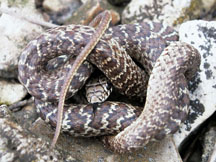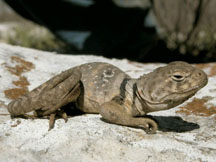
Kansas Herp Trip 2002
Saturday, April 27, 2002
Trip Details
Herpers: Jim Scharosch & Matt Ricklefs
Location: Wabaunsee County, KS.
Time: Started herpin' about Noon.
Temp/Conditions: Started out rainy and was cool. Approximately 55 - 60 degrees. Toward the later part of the day it became mostly sunny and about 67 degrees. It also became VERY windy with gusts up to an estimated 25 miles per hour.
We stopped at the local gas and shop to get some breakfast and say a coyote wandering about in a nearby field. This was pretty cool, but since we came to find herps were anxious to get going.
It was a bad sign that the first two pieces of tin we turned, where we had done well in years before, yielded a rat and a cat. Yes, we found an adult cat under a piece of tin. This was to say at least a bit discouraging. However we persevered since we had come all this way and we were determined to find something. We drove down one of many gravel roads and found a piece of tin. We were not expecting much since it was still cool and rainy we thought this would be a quick stop. Jim jumped out and to our surprise found an Eastern Yellow-Bellied Racer (Coluber constrictor flaviventris).
It did it's best to intimidate us with mouth open, but once we messed with it for a while it must have decided that we did not want to make it part of our breakfast and curled in defensive posture. Plus, it was cool, which makes working with snakes a little easier. It was approximately twenty-seven inches long. A nice specimen overall. We gained some confidence with this find and carried on. We were also encouraged with the clouds that were breaking up and the small slivers of sunlight that began to pierce the clouds and brighten our way. We found some abandon property that we had access to and explored the area. It was warming up now. We began to find Prairie Ringneck Snakes (Diadophis punctatus arnyi) regularly under tin and wood. Ringnecks are a good indicator species and are commonly encountered in Kansas. We also turned up our first Great Plains Skink (Eumeces obsoletus). These are large, beautiful skinks that are fairly variable in the shades of colors it has.
Some are more golden and some are browner with shades in between, age and sex also playing a part in this. We did find a juvenile Great Plains Skink only about four inches long. These are much darker, almost solid black, with some light flecking and a very pretty light bluish-purple tail. As we carried on we also found a juvenile Racer. Racers show a lot of variance from juvenile to adult as you can see in the pictures.
They are quite beautiful in both age ranges and, as we were to find out, are quite common in Kansas. We had finished with this spot and moseyed across the lone prairie. We encountered many turkey along the way, but nothing yet in the line of herps on the road to this point.
We carried on to an open field with some nice creek bottom gouged out of the hills. The wind was still blowing fiercely, but it was sunnier and a bit warmer. Along the hillside we encountered some very nice Red-Sided Garter Snakes (Thamnophis sirtalis parietalis).
Jim managed to snag a Boreal or Western Chorus Frog (Pseudacris maculata or Pseudacris triseriata).
The difference between the two is very slight according to Collins but "can be identified by their call and, to a lesser extent head width, leg length and tympanum diameter". So we got pictures of one of those.
We trekked across the hills to find a nice turnable rock area. These hills of rocks are the heart of the Flint Hills. Our target at this point was to find some Eastern Collared Lizards (Crotaphytus c. collaris). In the search we encountered dozens of mice under the rocks. Some would have up to seven mice underneath. We also encountered many "big, yellow" centipedes. These are quite impressive and intimidating when they catch you off guard. No doubt, large Collared Lizards have a feast with these kinds of prey. It was still fairly cool and extremely windy for lizards to be out basking, but rock turning paid off and we did encounter several young Collared Lizards.
We have been through these areas before and it is only a matter of time before you hit the right area. These are very fun to find and always provide a comical attitude and display. They are quite fierce acting when they need to be and once they flee they adopt the typical bi-pedal locomotion they are known for. They are fast, but you need to be patient. They know their range intimately, and when fleeing will go from rock to rock and usually circle back to their original hiding place. You can then attempt to capture again. If you're quick, you can usually get one. If it's really hot they are really fast and your odds decrease - considerably. On this day, however it was cool. They even calmed down enough to allow photos with out restraint - which is nice and more "natural" looking. Ah, the joys of nature photography...
At this point it was 5:45 pm so we decided to call it a day. On they way out of the area we encountered out first road find. An Ornate Box Turtle (Terrapene o. ornata) was making its way from field to field. Again, another common find in Kansas, but always a welcome one. Not only does it help to round out the list of species, but they are also quite comical looking.
This one was not much impressed by us and stayed in its shell, peering out only slightly. After a few pictures we got it off the road in the way it was heading and let it follow it path. That rounded out day one. We were pleased with the finds considering the weather we started out with!!










